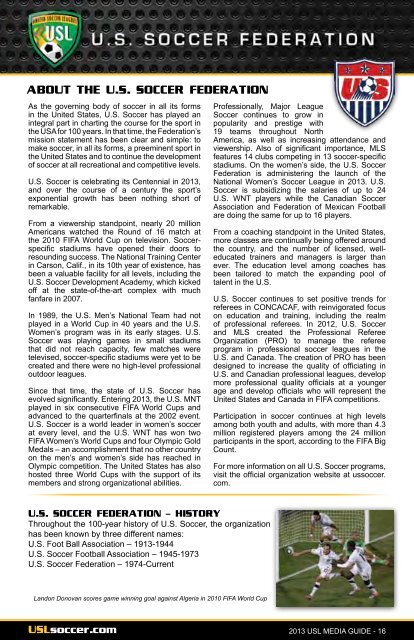2013 USL Media gUide - United Soccer Leagues
2013 USL Media gUide - United Soccer Leagues
2013 USL Media gUide - United Soccer Leagues
Create successful ePaper yourself
Turn your PDF publications into a flip-book with our unique Google optimized e-Paper software.
aBoUT The U.S. <strong>Soccer</strong> feDeraTion<br />
As the governing body of soccer in all its forms<br />
in the <strong>United</strong> States, U.S. <strong>Soccer</strong> has played an<br />
integral part in charting the course for the sport in<br />
the USA for 100 years. In that time, the Federation’s<br />
mission statement has been clear and simple: to<br />
make soccer, in all its forms, a preeminent sport in<br />
the <strong>United</strong> States and to continue the development<br />
of soccer at all recreational and competitive levels.<br />
U.S. <strong>Soccer</strong> is celebrating its Centennial in <strong>2013</strong>,<br />
and over the course of a century the sport’s<br />
exponential growth has been nothing short of<br />
remarkable.<br />
From a viewership standpoint, nearly 20 million<br />
Americans watched the Round of 16 match at<br />
the 2010 FIFA World Cup on television. <strong>Soccer</strong>specific<br />
stadiums have opened their doors to<br />
resounding success. The National Training Center<br />
in Carson, Calif., in its 10th year of existence, has<br />
been a valuable facility for all levels, including the<br />
U.S. <strong>Soccer</strong> Development Academy, which kicked<br />
off at the state-of-the-art complex with much<br />
fanfare in 2007.<br />
In 1989, the U.S. Men’s National Team had not<br />
played in a World Cup in 40 years and the U.S.<br />
Women’s program was in its early stages. U.S.<br />
<strong>Soccer</strong> was playing games in small stadiums<br />
that did not reach capacity, few matches were<br />
televised, soccer-specific stadiums were yet to be<br />
created and there were no high-level professional<br />
outdoor leagues.<br />
Since that time, the state of U.S. <strong>Soccer</strong> has<br />
evolved significantly. Entering <strong>2013</strong>, the U.S. MNT<br />
played in six consecutive FIFA World Cups and<br />
advanced to the quarterfinals at the 2002 event.<br />
U.S. <strong>Soccer</strong> is a world leader in women’s soccer<br />
at every level, and the U.S. WNT has won two<br />
FIFA Women’s World Cups and four Olympic Gold<br />
Medals – an accomplishment that no other country<br />
on the men’s and women’s side has reached in<br />
Olympic competition. The <strong>United</strong> States has also<br />
hosted three World Cups with the support of its<br />
members and strong organizational abilities.<br />
U.S. <strong>Soccer</strong> feDeraTion – hiSTorY<br />
Throughout the 100-year history of U.S. <strong>Soccer</strong>, the organization<br />
has been known by three different names:<br />
U.S. Foot Ball Association – 1913-1944<br />
U.S. <strong>Soccer</strong> Football Association – 1945-1973<br />
U.S. <strong>Soccer</strong> Federation – 1974-Current<br />
Landon Donovan scores game winning goal against Algeria in 2010 FIFA World Cup<br />
<strong>USL</strong>soccer.com<br />
Professionally, Major League<br />
<strong>Soccer</strong> continues to grow in<br />
popularity and prestige with<br />
19 teams throughout North<br />
america, as well as increasing attendance and<br />
viewership. Also of significant importance, MLS<br />
features 14 clubs competing in 13 soccer-specific<br />
stadiums. On the women’s side, the U.S. <strong>Soccer</strong><br />
Federation is administering the launch of the<br />
National Women’s <strong>Soccer</strong> League in <strong>2013</strong>. U.S.<br />
<strong>Soccer</strong> is subsidizing the salaries of up to 24<br />
U.S. WNT players while the Canadian <strong>Soccer</strong><br />
Association and Federation of Mexican Football<br />
are doing the same for up to 16 players.<br />
From a coaching standpoint in the <strong>United</strong> States,<br />
more classes are continually being offered around<br />
the country, and the number of licensed, welleducated<br />
trainers and managers is larger than<br />
ever. The education level among coaches has<br />
been tailored to match the expanding pool of<br />
talent in the U.S.<br />
U.S. <strong>Soccer</strong> continues to set positive trends for<br />
referees in CONCACAF, with reinvigorated focus<br />
on education and training, including the realm<br />
of professional referees. In 2012, U.S. <strong>Soccer</strong><br />
and MLS created the Professional Referee<br />
Organization (PRO) to manage the referee<br />
program in professional soccer leagues in the<br />
U.S. and Canada. The creation of PRO has been<br />
designed to increase the quality of officiating in<br />
U.S. and Canadian professional leagues, develop<br />
more professional quality officials at a younger<br />
age and develop officials who will represent the<br />
<strong>United</strong> States and Canada in FIFA competitions.<br />
Participation in soccer continues at high levels<br />
among both youth and adults, with more than 4.3<br />
million registered players among the 24 million<br />
participants in the sport, according to the FIFA Big<br />
Count.<br />
For more information on all U.S. <strong>Soccer</strong> programs,<br />
visit the official organization website at ussoccer.<br />
com.<br />
<strong>2013</strong> <strong>USL</strong> <strong>Media</strong> <strong>gUide</strong> - 16





